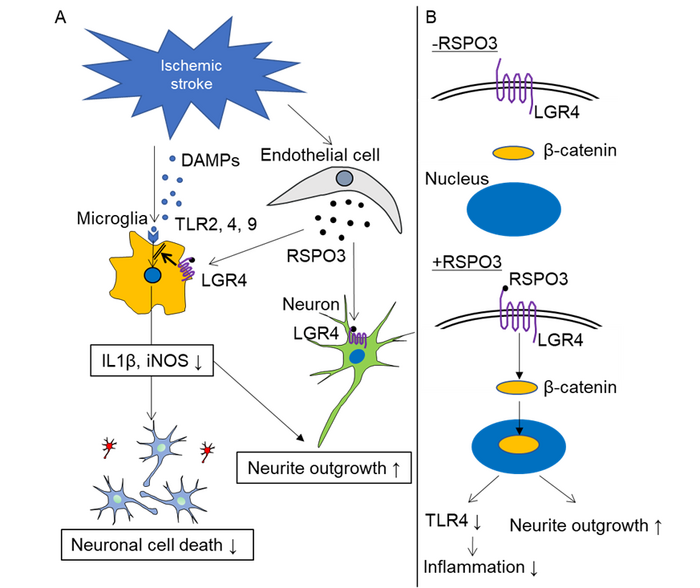Osaka, Japan – Ischemic stroke, caused by a blockage of blood flow to the brain, is a common cause of death and disability. Treatments are urgently needed to improve patient outcomes, because recovery currently depends largely on the timely injection of a blood clot-dissolving drug. Priorities for therapy include limiting inflammation at the ischemic site and rebuilding neuronal connections damaged by the stroke. However, a molecule that can achieve these therapeutic effects has remained elusive.

Credit: Stroke in Press
Osaka, Japan – Ischemic stroke, caused by a blockage of blood flow to the brain, is a common cause of death and disability. Treatments are urgently needed to improve patient outcomes, because recovery currently depends largely on the timely injection of a blood clot-dissolving drug. Priorities for therapy include limiting inflammation at the ischemic site and rebuilding neuronal connections damaged by the stroke. However, a molecule that can achieve these therapeutic effects has remained elusive.
In a study to be published in Stroke, researchers from Osaka University provide new hope for patients. They have identified two proteins, R-spondin 3 (RSPO3) and LGR4, that trigger a cascade of reactions in cells (i.e., a signaling pathway) to reduce inflammation in the ischemic brain. RSPO3 and LGR4 also stimulate the growth of extensions from neurons, a process called neurite outgrowth.
“Previous studies showed that RSPO3 was beneficial in lung injuries caused by inflammation. We also knew that RSPO3 stimulates a signaling pathway, named the ‘canonical Wnt pathway’, that promotes neurite outgrowth,” explains Munehisa Shimamura, lead author of the study. “We wondered whether RSPO3 reduces inflammation and promotes neurite outgrowth after ischemic stroke.”
Previous studies have shown that RSPO3 and LGR4 are present in the same brain structures, and that RSPO3 activates LGR4 to stimulate the canonical Wnt pathway. The team from Osaka University localized RSPO3 in endothelial cells and LGR4 in microglia/macrophage cells and neurons in the ischemic brain.
“Because of this close localization, RSPO3 could act on LGR4,” explains Hironori Nakagami, a senior author of the study. “To test this hypothesis, we injected RSPO3 into the brains of mice 24 and 48 hours after ischemic stroke.”
Remarkably, nine days after the stroke, mice that were injected with RSPO3 exhibited fewer sensory and motor deficits than mice injected with a control protein. The expression of pro-inflammatory factors was reduced, whereas signs of neurite outgrowth increased. How? The researchers found that RSPO3/LGR4 decreased the expression of TLR4, which is one of proteins essential for inducing inflammation.
These findings are particularly exciting because RPSO3 was given to mice one day after the stroke, suggesting a potential benefit to treatments in later stages of stroke. Thus, targeting RSPO3/LGR4 signaling is a promising lead for developing new therapies for ischemic stroke and improving patient outcomes.
###
The article, “R-spondin 3/LGR4 axis is a novel inflammatory and neurite outgrowth signaling system in the ischemic brain in mice,” will be published in Stroke at DOI: https://doi.org/10.1161/STROKEAHA.122.041970
About Osaka University
Osaka University was founded in 1931 as one of the seven imperial universities of Japan and is now one of Japan’s leading comprehensive universities with a broad disciplinary spectrum. This strength is coupled with a singular drive for innovation that extends throughout the scientific process, from fundamental research to the creation of applied technology with positive economic impacts. Its commitment to innovation has been recognized in Japan and around the world, being named Japan’s most innovative university in 2015 (Reuters 2015 Top 100) and one of the most innovative institutions in the world in 2017 (Innovative Universities and the Nature Index Innovation 2017). Now, Osaka University is leveraging its role as a Designated National University Corporation selected by the Ministry of Education, Culture, Sports, Science and Technology to contribute to innovation for human welfare, sustainable development of society, and social transformation.
Website: https://resou.osaka-u.ac.jp/en
Journal
Stroke
DOI
10.1161/STROKEAHA.122.041970
Method of Research
Experimental study
Subject of Research
Animals
Article Title
R-spondin 3/LGR4 axis is a novel inflammatory and neurite outgrowth signaling system in the ischemic brain in mice
Article Publication Date
11-May-2023




